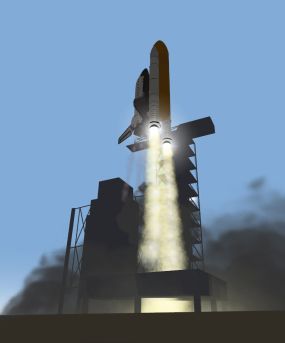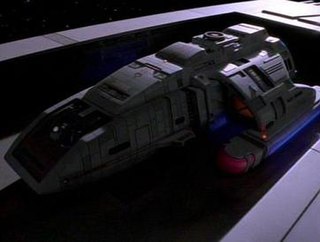Related Research Articles

Interplanetary spaceflight or interplanetary travel is the crewed or uncrewed travel between stars and planets, usually within a single planetary system. In practice, spaceflights of this type are confined to travel between the planets of the Solar System. Uncrewed space probes have flown to all the observed planets in the Solar System as well as to dwarf planets Pluto and Ceres, and several asteroids. Orbiters and landers return more information than fly-by missions. Crewed flights have landed on the Moon and have been planned, from time to time, for Mars, Venus and Mercury. While many scientists appreciate the knowledge value that uncrewed flights provide, the value of crewed missions is more controversial. Science fiction writers propose a number of benefits, including the mining of asteroids, access to solar power, and room for colonization in the event of an Earth catastrophe.

The Mariner program was conducted by the American space agency NASA to explore other planets. Between 1962 and late 1973, NASA's Jet Propulsion Laboratory (JPL) designed and built 10 robotic interplanetary probes named Mariner to explore the inner Solar System - visiting the planets Venus, Mars and Mercury for the first time, and returning to Venus and Mars for additional close observations.

A spacecraft is a vehicle that is designed to fly in outer space and operate there. Spacecraft are used for a variety of purposes, including communications, Earth observation, meteorology, navigation, space colonization, planetary exploration, and transportation of humans and cargo. All spacecraft except single-stage-to-orbit vehicles cannot get into space on their own, and require a launch vehicle.

Spaceflight is an application of astronautics to fly objects, usually spacecraft, into or through outer space, either with or without humans on board. Most spaceflight is uncrewed and conducted mainly with spacecraft such as satellites in orbit around Earth, but also includes space probes for flights beyond Earth orbit. Such spaceflight operate either by telerobotic or autonomous control. The more complex human spaceflight has been pursued soon after the first orbital satellites and has reached the Moon and permanent human presence in space around Earth, particularly with the use of space stations. Human spaceflight programs include the Soyuz, Shenzhou, the past Apollo Moon landing and the Space Shuttle programs. Other current spaceflight are conducted to the International Space Station and to China's Tiangong Space Station.

Orbiter is a space flight simulator program developed to simulate spaceflight using realistic Newtonian physics. The simulator was released on 27 November 2000; the latest edition, labeled "Orbiter 2016", was released on 30 August 2016, the first new version of the simulator since 2010. On 27 July 2021, Dr Schweiger announced to the Orbiter Community that Orbiter is being published under open source MIT license.

A spaceplane is a vehicle that can fly and glide like an aircraft in Earth's atmosphere and maneuver like a spacecraft in outer space. To do so, spaceplanes must incorporate features of both aircraft and spacecraft. Orbital spaceplanes tend to be more similar to conventional spacecraft, while sub-orbital spaceplanes tend to be more similar to fixed-wing aircraft. All spaceplanes to date have been rocket-powered for takeoff and climb, but have then landed as unpowered gliders.

Runabouts are a fictional class of small, multi-purpose starships appearing in the Star Trek science-fiction franchise, primarily the television series Star Trek: Deep Space Nine, which aired on syndicated television between 1993 and 1999. They served as a means of transport for the crew of the fictional space station Deep Space Nine, in the early seasons of the series enabling storylines taking place away from the station.

An escape pod, escape capsule, life capsule, or lifepod is a capsule or craft, usually only big enough for one person, used to escape from a vessel in an emergency. An escape ship is a larger, more complete craft also used for the same purpose. Escape pods are ubiquitous in science fiction but are only used in a few real vehicles.

A mother ship, mothership or mother-ship is a large vehicle that leads, serves, or carries other smaller vehicles. A mother ship may be a maritime ship, aircraft, or spacecraft.

Air launching is the practice of releasing a rocket, missile, parasite aircraft or other aircraft payload from a mother ship or launch aircraft. The payload craft or missile is often tucked under the wing of the larger mother ship and then "dropped" while in flight. It may also be stored within a bomb bay, beneath the main fuselage or even on the back of the carrier aircraft, as in the case of the D-21 drone. Air launching provides several advantages over ground launching, giving the smaller craft an altitude and range boost, while saving it the weight of the fuel and equipment needed to take off on its own.

Artificial gravity is the creation of an inertial force that mimics the effects of a gravitational force, usually by rotation. Artificial gravity, or rotational gravity, is thus the appearance of a centrifugal force in a rotating frame of reference, as opposed to the force experienced in linear acceleration, which by the equivalence principle is indistinguishable from gravity. In a more general sense, "artificial gravity" may also refer to the effect of linear acceleration, e.g. by means of a rocket engine.
Shuttlecraft are fictional vehicles in the Star Trek science fiction franchise built for short trips in space, such as between a planetary surface and orbit. Also referred to as shuttles, their introduction preceded the development of the Space Shuttle.

Aerocapture is an orbital transfer maneuver in which a spacecraft uses aerodynamic drag force from a single pass through a planetary atmosphere to decelerate and achieve orbit insertion.

"The Slaver Weapon" is the fourteenth episode of the first season of the American animated science fiction television series Star Trek: The Animated Series. It first aired on NBC on December 8, 1973, and was written by Larry Niven. It was based on his original short story "The Soft Weapon". This episode was expanded to become the first half of a full-length novel by science-fiction author Alan Dean Foster as Star Trek Log Ten.
A space dock is a hypothesised type of space station that is able to repair or build spacecraft similar to maritime shipyards on Earth. They remove the need for new spacecraft to perform a space launch to reach space and existing spacecraft to make an atmospheric entry and landing for repair work. They currently only exist in fiction, however concept work has been undertaken on real space dock facilities that could be built with current technology.
Lego Mars Mission was a Lego subtheme to Lego Space that sold from 2007 to 2009. It is set on Mars and features astronauts, aliens, and high-tech machinery.

The Mars Project is a 1952 non-fiction scientific book by the German rocket physicist, astronautics engineer and space architect Wernher von Braun. It was translated from the original German by Henry J. White and first published in English by the University of Illinois Press in 1953.
The Star Trek franchise features many spacecraft. Various space vessels make up the primary settings of the Star Trek television series, films, and expanded universe; others help advance the franchise's stories. Throughout the franchise's production, spacecraft have been depicted by numerous physical and computer-generated models. Producers worked to balance often tight budgets with the need to depict convincing, futuristic vessels.

Galileo is a fictional spacecraft that appeared in the 1960s American science-fiction television series Star Trek. It was a shuttlecraft assigned to the USS Enterprise, and was the first of its type to be seen on screen in the franchise, appearing in the episode "The Galileo Seven". It appeared an additional four times in the series before being replaced by the Galileo II, a repaint of the full-size exterior model.
References
- 1 2 Inhabitant (2008) [1881]. Alessio, Dominic (ed.). The Great Romance: a Rediscovered Utopian Adventure . Lincoln: University of Nebraska Press. p. 28. ISBN 978-0803259966. OCLC 171287687.
- ↑ Crystal, David (18 September 2014). Words in time and place : exploring language through the Historical Thesaurus of the Oxford English Dictionary (1st ed.). Oxford [England]. ISBN 978-0191501654. OCLC 889211169.
{{cite book}}: CS1 maint: location missing publisher (link) - 1 2 Faure, Gunter; Mensing, Teresa M. (2007). Introduction to planetary science : the geological perspective. Dordrecht: Springer. ISBN 978-1402055447. OCLC 187312870.